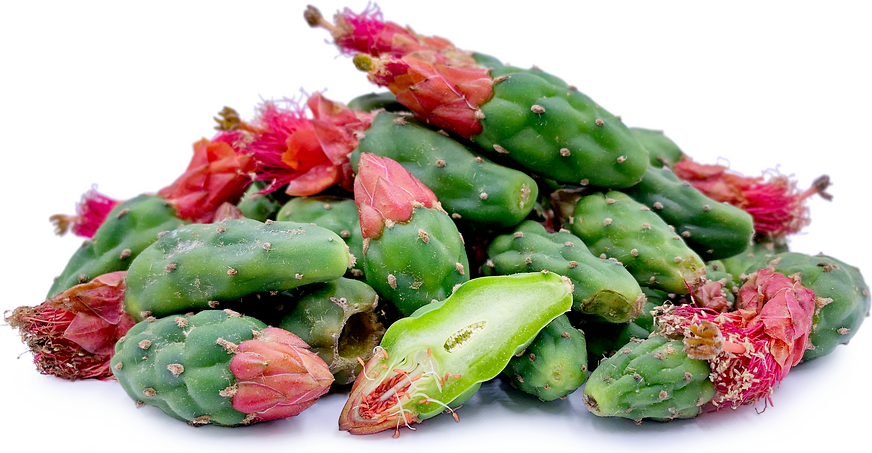


Nopales Cactus Buds
Estimated Inventory, lb : 0
Description/Taste
Nopales Cactus Buds are small in size, averaging 2-5 centimeters in length, and are cylindrical to oblong in shape tapering slightly at both ends. At the bottom of the bud, the smooth, firm green skin is ridged with small bumps, and underneath the surface, the flesh is crisp, tender, and mucilaginous. From the green base, the flesh fades into bright pink to fuschia flower petals that are tightly wrapped, soft, and delicate, encasing thin stamens in the center of the petals. Nopales Cactus Buds are mild, crunchy, and succulent with a green, slightly tangy flavor reminiscent of asparagus and green beans.
Seasons/Availability
Nopales Cactus Buds are available in the early spring through summer.
Current Facts
Nopales Cactus Buds, botanically classified as Opuntia ficus-indica, are small nodules that form on the end of the pad on the prickly pear cactus, which belongs to the Cactaceae family. These small buds bloom into vibrant colored flowers of yellow, magenta, red, or orange, and then eventually the bloom gives way to the prickly pear fruit, also known as a tuna. Prickly pear cacti are predominately known for their edible pads and fruit, but the buds have remained relatively unknown as a consumable item. Though rare in the mass commercial market, Nopales Cactus Buds are increasingly in popularity at specialty markets and are harvested in the spring, favored for their tangy, green flavor. Caution should be taken if harvesting from the wild as some varieties are spineless while other varieties may bear glochids, which are delicate spines that are easily lodged into the skin and can cause irritation.
Nutritional Value
Nopales Cactus Buds contain vitamins A, B, and C, and iron.
Applications
Nopales Cactus Buds are best suited for cooked applications such as steaming, baking, and boiling. The buds can be baked, skewered, and used as an appetizer, dipped in sauces such as bar-be-que and soy sauce, or sprinkled with balsamic, sea salt, and vinegar. The buds can also be boiled and mixed with other cooked vegetables in a stir-fry, steamed, coated in butter, and served with sautéed onions, tossed into salads, incorporated into stews, roasts, and casseroles, or cooked into egg dishes and quiches. In addition to cooked applications, Nopales Cactus Buds can be dehydrated and reconstituted when needed. In this form, the buds can be ground into a fine powder and used as a thickener in gravy and sauces. They can also be pickled and stored for extended use. Nopales Cactus Buds pair well with carrots, celery, green beans, corn, sweet bell peppers, tomatoes, cilantro, oregano, potatoes, scallions, onions, parmesan cheese, salsa, eggs, poultry, pork, and beef. The fresh buds will keep up to one week when stored in the refrigerator.
Ethnic/Cultural Info
Nopales Cactus Buds grow on the prickly pear cactus which is one of the most popular cacti species found in the Southwestern United States. There are more than three hundred varieties of prickly pear cacti present throughout North, Central, and South America and the pads, fruit, and buds are used by local tribes as a source of food and medicine. In the United States, the prickly pear is the state cactus of Texas and has been used by Native Americans as a medicinal aid to reduce symptoms associated with sunburns, gastrointestinal issues, and colds. In addition to human consumption, the prickly pear cactus also provides food and shelter to reptiles, birds, tortoises, deer, and rabbits.
Geography/History
The Nopales Cactus is native to Central Mexico where it has been growing wild since ancient times and was believed to have been used as a source of food over 9,000 years ago. As humans migrated and spread throughout the Americas and then eventually encountered trade ships from Europe, the cactus was spread across the world and was established in many different regions. Today the species is commonly cultivated and found growing in Mediterranean climates and is available in the wild and through local markets in North, Central, and South America, Europe, Africa, Asia, and Australia. The Nopales Cactus Buds shown in the photograph above were found in Miami, Florida.




